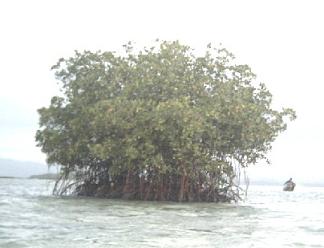Mangrove, is a tree that grows along tropical coasts in salty ocean water. The best-known species is the red mangrove. As this type of mangrove develops, it sends down roots from its branches. Eventually, a network of many stiltlike roots supports its leafy crown above the water. Mangroves form the chief plant growth along long stretches of tropical coasts. They usually grow in places by quiet ocean water.

Large mangrove thickets, or forests on stilts, often grow in shallow waters along bays, lagoons, and river mouths. The thousands of stiltlike roots catch silt, which piles up in the water. At the mouths of streams, the roots slow down the current and help settle the silt. Thus, mangroves may aid in building up dry land. The roots also form a breeding place for many fish and other marine life.

Mangrove forests protect coastal areas from the full force of storm waves. They also act as a filter by trapping pollutants washed down from the land.
|
